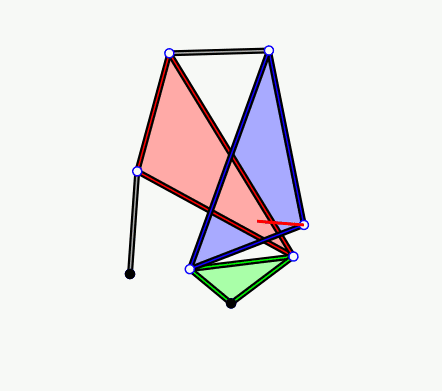|
Snark (graph Theory)
In the mathematical field of graph theory, a snark is an undirected graph with exactly three edges per vertex whose edges cannot be colored with only three colors. In order to avoid trivial cases, snarks are often restricted to have additional requirements on their connectivity and on the length of their cycles. Infinitely many snarks exist. One of the equivalent forms of the four color theorem is that every snark is a non-planar graph. Research on snarks originated in Peter G. Tait's work on the four color theorem in 1880, but their name is much newer, given to them by Martin Gardner in 1976. Beyond coloring, snarks also have connections to other hard problems in graph theory: writing in the ''Electronic Journal of Combinatorics'', Miroslav Chladný and Martin Škoviera state that As well as the problems they mention, W. T. Tutte's ''snark conjecture'' concerns the existence of Petersen graphs as graph minors of snarks; its proof has been long announced but remains unp ... [...More Info...] [...Related Items...] OR: [Wikipedia] [Google] [Baidu] |
Descartes Snark
In the mathematical field of graph theory, a Descartes snark is an undirected graph with 210 vertices and 315 edges. It is a snark, first discovered by William Tutte in 1948 under the pseudonym Blanche Descartes.Descartes, Blanche. Network Colorings" ''The Mathematical Gazette'' (London, 32:299. p. 67–69, 1948. A Descartes snark is obtained from the Petersen graph by replacing each vertex with a nonagon In geometry, a nonagon () or enneagon () is a nine-sided polygon or 9-gon. The name ''nonagon'' is a prefix hybrid formation, from Latin (''nonus'', "ninth" + ''gonon''), used equivalently, attested already in the 16th century in French ''nonogo ... and each edge with a particular graph closely related to the Petersen graph. Because there are multiple ways to perform this procedure, there are multiple Descartes snarks. References Graph families {{combin-stub ... [...More Info...] [...Related Items...] OR: [Wikipedia] [Google] [Baidu] |
Graph Minor
In graph theory, an undirected graph is called a minor of the graph if can be formed from by deleting edges and vertices and by contracting edges. The theory of graph minors began with Wagner's theorem that a graph is planar if and only if its minors include neither the complete graph nor the complete bipartite graph ., p. 77; . The Robertson–Seymour theorem implies that an analogous forbidden minor characterization exists for every property of graphs that is preserved by deletions and edge contractions., theorem 4, p. 78; . For every fixed graph , it is possible to test whether is a minor of an input graph in polynomial time; together with the forbidden minor characterization this implies that every graph property preserved by deletions and contractions may be recognized in polynomial time. Other results and conjectures involving graph minors include the graph structure theorem, according to which the graphs that do not have as a minor may be formed by glui ... [...More Info...] [...Related Items...] OR: [Wikipedia] [Google] [Baidu] |
Rufus Isaacs (game Theorist)
Rufus Philip Isaacs (June 11, 1914 – January 18, 1981) was a game theorist especially prominent in the 1950s and 1960s with his work on differential games. Biography Isaacs was born on 11 June 1914 in New York City. He worked for the RAND Corporation from 1948 until winter 1954/1955. His investigation stemmed from classic pursuit–evasion type zero-sum dynamic two-player games such as the Princess and monster game. In 1942, he married Rose Bicov, and they had two daughters. His work in pure mathematics included working with monodiffric functions, fractional-order mappings, graph theory, analytic functions, and number theory. In graph theory he constructed the first two infinite families of snarks. In applied mathematics, he worked with aerodynamics, elasticity, optimization, and differential games, which he is most known for. He received his bachelor's degree from MIT in 1936, and received his MA and PhD from Columbia University in 1942 and 1943 respectively. His first ... [...More Info...] [...Related Items...] OR: [Wikipedia] [Google] [Baidu] |
George Szekeres
George Szekeres AM FAA (; 29 May 1911 – 28 August 2005) was a Hungarian–Australian mathematician. Early years Szekeres was born in Budapest, Hungary, as Szekeres György and received his degree in chemistry at the Technical University of Budapest. He worked six years in Budapest as an analytical chemist. He married Esther Klein in 1937.Obituary The Sydney Morning Herald Being , the family had to escape from the persecution so Szekeres took a job in Shanghai, China. There they lived through World War II, the Japanese occupation and the beginn ... [...More Info...] [...Related Items...] OR: [Wikipedia] [Google] [Baidu] |
Szekeres Snark
In the mathematical field of graph theory, the Szekeres snark is a snark with 50 vertices and 75 edges. It was the fifth known snark, discovered by George Szekeres in 1973. As a snark, the Szekeres graph is a connected, bridgeless cubic graph with chromatic index equal to 4. The Szekeres snark is non-planar and non-hamiltonian but is hypohamiltonian. It has book thickness 3 and queue number 2. Another well known snark on 50 vertices is the Watkins snark discovered by John J. Watkins in 1989.Watkins, J. J. "Snarks." Ann. New York Acad. Sci. 576, 606-622, 1989. Gallery Image:Szekeres snark 3COL.svg, The chromatic number of the Szekeres snark is 3. Image:Szekeres snark 4color edge.svg, The chromatic index In graph theory, an edge coloring of a graph is an assignment of "colors" to the edges of the graph so that no two incident edges have the same color. For example, the figure to the right shows an edge coloring of a graph by the colors red, blue ... of the Szekeres snark ... [...More Info...] [...Related Items...] OR: [Wikipedia] [Google] [Baidu] |
Bill Tutte
William Thomas Tutte OC FRS FRSC (; 14 May 1917 – 2 May 2002) was an English and Canadian codebreaker and mathematician. During the Second World War, he made a brilliant and fundamental advance in cryptanalysis of the Lorenz cipher, a major Nazi German cipher system which was used for top-secret communications within the Wehrmacht High Command. The high-level, strategic nature of the intelligence obtained from Tutte's crucial breakthrough, in the bulk decrypting of Lorenz-enciphered messages specifically, contributed greatly, and perhaps even decisively, to the defeat of Nazi Germany. He also had a number of significant mathematical accomplishments, including foundation work in the fields of graph theory and matroid theory. Tutte's research in the field of graph theory proved to be of remarkable importance. At a time when graph theory was still a primitive subject, Tutte commenced the study of matroids and developed them into a theory by expanding from the work that Hassler ... [...More Info...] [...Related Items...] OR: [Wikipedia] [Google] [Baidu] |
Danilo Blanuša
Danilo Blanuša ( sr-cyr, Данило Блануша; 7 December 1903 – 8 August 1987) was a Croatian Serb mathematician, physicist, engineer and a professor at the University of Zagreb. Biography Blanuša was born in Osijek, Austria-Hungary (today Croatia), into an ethnic Serb family. He attended elementary school in Vienna and Steyr in Austria and gymnasium in Osijek and Zagreb. He studied engineering in both Zagreb and Vienna and also mathematics and physics. His career started in Zagreb, where he started to work and lecture. His student Mileva Prvanović completed her doctorate in 1955, the first in geometry in Serbia. Blanuša was the dean of the Faculty of Electrical Engineering, Zagreb in the 1957–58 school year. He received the Ruđer Bošković prize in 1960. He died in Zagreb. Mathematics In mathematics, Blanuša became known for discovering the second and third known snarks in 1946 (the Petersen graph was the first), triggering a new area of graph theory. T ... [...More Info...] [...Related Items...] OR: [Wikipedia] [Google] [Baidu] |
Blanuša Snarks
In the mathematical field of graph theory, the Blanuša snarks are two 3-regular graphs with 18 vertices and 27 edges. They were discovered by Yugoslavian mathematician Danilo Blanuša in 1946 and are named after him. When discovered, only one snark was known—the Petersen graph. As snarks, the Blanuša snarks are connected, bridgeless cubic graphs with chromatic index equal to 4. Both of them have chromatic number 3, diameter 4 and girth 5. They are non-hamiltonian but are hypohamiltonian. Both have book thickness 3 and queue number 2. Algebraic properties The automorphism group of the first Blanuša snark is of order 8 and is isomorphic to the Dihedral group ''D''4, the group of symmetries of a square. The automorphism group of the second Blanuša snark is an abelian group of order 4 isomorphic to the Klein four-group, the direct product of the Cyclic group Z/2Z with itself. The characteristic polynomial of the first and the second Blanuša snark are respectively : :(x ... [...More Info...] [...Related Items...] OR: [Wikipedia] [Google] [Baidu] |
Alfred Kempe
Sir Alfred Bray Kempe FRS (6 July 1849 – 21 April 1922) was a mathematician best known for his work on linkages and the four colour theorem. Biography Kempe was the son of the Rector of St James's Church, Piccadilly, the Rev. John Edward Kempe. He was educated at St Paul's School, London and then studied at Trinity College, Cambridge, where Arthur Cayley was one of his teachers. He graduated BA (22nd wrangler) in 1872. Despite his interest in mathematics he became a barrister, specialising in the ecclesiastical law. He was knighted in 1913, the same year he became the Chancellor for the Diocese of London. He was also Chancellor of the dioceses of Newcastle, Southwell, St Albans, Peterborough, Chichester, and Chelmsford. He received the honorary degree DCL from the University of Durham and he was elected a Bencher of the Inner Temple in 1909. In 1876 he published his article ''On a General Method of describing Plane Curves of the nth degree by Linkwork,'' which presented a ... [...More Info...] [...Related Items...] OR: [Wikipedia] [Google] [Baidu] |
Julius Petersen
Julius Peter Christian Petersen (16 June 1839, Sorø, West Zealand – 5 August 1910, Copenhagen) was a Danish mathematician. His contributions to the field of mathematics led to the birth of graph theory. Biography Petersen's interests in mathematics were manifold, including: geometry, complex analysis, number theory, mathematical physics, mathematical economics, cryptography and graph theory. His famous paper ''Die Theorie der regulären graphs'' was a fundamental contribution to modern graph theory as we know it today. In 1898, he presented a counterexample to Tait's claimed theorem about 1-factorability of 3-regular graphs, which is nowadays known as the "Petersen graph". In cryptography and mathematical economics he made contributions which today are seen as pioneering. He published a systematic treatment of geometrical constructions (with straightedge and compass) in 1880. A French translation was reprinted in 1990. A special issue of Discrete Mathematics has ... [...More Info...] [...Related Items...] OR: [Wikipedia] [Google] [Baidu] |
Planar Graph
In graph theory, a planar graph is a graph that can be embedded in the plane, i.e., it can be drawn on the plane in such a way that its edges intersect only at their endpoints. In other words, it can be drawn in such a way that no edges cross each other. Such a drawing is called a plane graph or planar embedding of the graph. A plane graph can be defined as a planar graph with a mapping from every node to a point on a plane, and from every edge to a plane curve on that plane, such that the extreme points of each curve are the points mapped from its end nodes, and all curves are disjoint except on their extreme points. Every graph that can be drawn on a plane can be drawn on the sphere as well, and vice versa, by means of stereographic projection. Plane graphs can be encoded by combinatorial maps or rotation systems. An equivalence class of topologically equivalent drawings on the sphere, usually with additional assumptions such as the absence of isthmuses, is called a pl ... [...More Info...] [...Related Items...] OR: [Wikipedia] [Google] [Baidu] |



